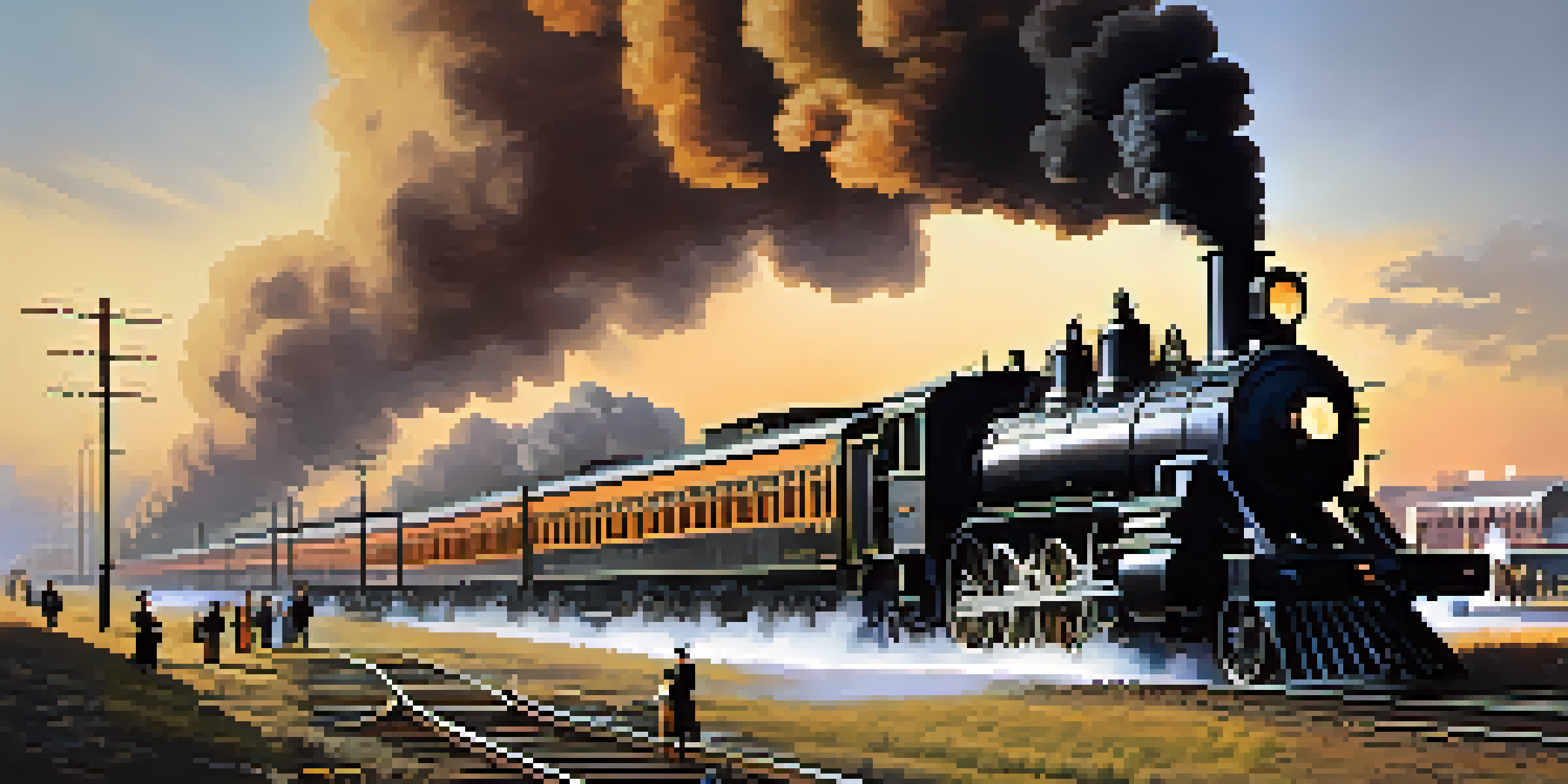Exploring Buffalo's Early Railroads: A Journey Through Time

The Birth of Buffalo's Railroads in the Early 19th Century
Buffalo's railroad history began in the early 1800s, a time when the city was rapidly evolving. The Erie Canal, completed in 1825, served as a crucial catalyst, enabling goods to flow freely between the Atlantic and the Great Lakes. This newfound accessibility attracted entrepreneurs and settlers who saw potential in Buffalo as a transportation hub.
The railroads brought a new era of commerce and community to Buffalo, transforming it into a bustling hub of opportunity.
By the mid-1830s, the first railroads began to emerge, connecting Buffalo to other key cities like Rochester and Syracuse. These railroads not only facilitated trade but also encouraged population growth, as people flocked to Buffalo for jobs and opportunities. The advent of rail travel marked a transformative period, moving Buffalo from a regional player to a pivotal stop on the national transportation map.
As the railroads expanded, Buffalo's economy flourished, setting the stage for its emergence as a major industrial center. Factories and warehouses sprang up around the rail yards, creating a bustling landscape filled with activity. This early growth laid the groundwork for the city's future successes, making it a beacon of innovation and commerce.
The Impact of the New York Central Railroad
The New York Central Railroad (NYCRR) played a significant role in shaping Buffalo's railroad landscape. Established in the mid-19th century, it became one of the largest and most influential rail systems in the United States. The NYCRR connected Buffalo to New York City and other major markets, allowing for the easy movement of people and goods.

With the construction of the grand New York Central Depot in 1877, Buffalo gained a railway terminal that was both functional and aesthetically pleasing. This hub became a social and commercial center, as travelers and locals alike gathered for transportation and trade. The depot symbolized Buffalo's growing importance in the railroad industry, drawing attention to its vibrant economy.
Buffalo's Early Railroad Growth
The establishment of railroads in the early 19th century transformed Buffalo into a key transportation hub, boosting trade and population.
The NYCRR's impact extended beyond transportation; it fostered a sense of community and connected families across distances. As people traveled for work, leisure, and reunions, the railroad helped weave Buffalo into the fabric of American life. This connectivity was crucial in establishing Buffalo as a key player in the national economy.
The Rise of Local Railroads: A Focus on the Buffalo, Rochester and Pittsburgh
In addition to the major railroads, local lines like the Buffalo, Rochester and Pittsburgh Railway emerged, catering to specific regional needs. These railroads focused on connecting smaller towns and industries to Buffalo's bustling market. This local focus allowed for more personalized service and flexibility in transportation, which larger railroads often couldn't provide.
A city’s railroads are the veins of its economy, pumping life into its industries and connecting its people.
The Buffalo, Rochester and Pittsburgh Railway played a vital role in transporting coal and other resources essential for industry. This not only supported Buffalo's factories but also helped fuel the growth of nearby towns. The local railroads became lifelines for communities, ensuring that goods could be shipped efficiently and economically.
As these local railroads thrived, they contributed to the overall prosperity of Buffalo. Businesses relied on them to transport products, while residents benefited from improved access to markets and jobs. By fostering a web of connections, local railroads added depth to Buffalo's transportation network and reinforced its status as an industrial powerhouse.
The Golden Age of Railroads in Buffalo
The late 19th and early 20th centuries marked the golden age of railroads in Buffalo, with the city becoming one of the busiest rail hubs in the country. With multiple rail lines operating, the city's landscape transformed, filled with depots, freight yards, and bustling activity. This era brought significant economic growth, as railroads became the backbone of Buffalo's industry.
During this period, innovations such as the introduction of passenger trains made travel more comfortable and accessible. The development of dining cars and sleeper services transformed train travel into a more enjoyable experience. This shift attracted more travelers, further enhancing the importance of Buffalo as a key transit point.
The Golden Age of Railroads
Buffalo became a bustling rail hub in the late 19th and early 20th centuries, leading to significant economic growth and cultural diversity.
As the railroads flourished, so did the surrounding communities, leading to an increase in population and diversity. Buffalo became a melting pot as immigrants arrived, drawn by job opportunities in the railroad and industrial sectors. This cultural richness added vibrancy to the city's identity, forever linking Buffalo's growth to its railroads.
The Decline of Railroads and the Shift to Other Modes of Transport
Despite their golden age, the mid-20th century saw a decline in railroad usage, influenced by the rise of automobiles and air travel. As more people opted for personal vehicles, railroads faced challenges in maintaining their relevance. This shift led to a gradual decrease in passenger services and the closure of many lines, impacting Buffalo's economy and transportation landscape.
The decline of the railroads also brought about significant changes in Buffalo's infrastructure. Freight transportation increasingly relied on trucks, leading to a transformation of the city's logistics network. While the convenience of road travel was undeniable, it also meant that the once-bustling railroads were often overlooked and underutilized.
Buffalo's rail history didn't vanish entirely, though. The remnants of the railroad era can still be seen in the city today, as many old tracks and depots have been repurposed for modern uses. This adaptation reflects a resilience in Buffalo's spirit, as the city embraces its past while moving forward into a new transportation era.
Revitalization Efforts: Preserving Buffalo's Railroad Heritage
In recent years, there has been a renewed interest in preserving Buffalo's railroad heritage. Local organizations and enthusiasts work tirelessly to restore historical sites and educate the public about the city's rich railroad past. These efforts aim not only to honor the legacy of the railroads but also to inspire future generations.
One notable initiative is the preservation of the Buffalo Central Terminal, a stunning example of Art Deco architecture that once served as a bustling hub for travelers. Restoration projects have breathed new life into this historic site, turning it into a venue for community events and educational programs. Such initiatives highlight the importance of maintaining a connection to the past.
Future of Railroads in Buffalo
Buffalo's railroads are set for a revitalization, focusing on sustainable transportation and modern technology to enhance the city's logistics.
Through these revitalization efforts, Buffalo is reclaiming its identity as a city with a significant railroad history. By showcasing its heritage, Buffalo not only pays tribute to those who came before but also positions itself as a destination for history enthusiasts and tourists alike. The ongoing commitment to preservation speaks to the city's resilience and pride in its unique story.
The Future of Railroads in Buffalo: A New Chapter Awaits
As we look to the future, Buffalo's railroads are poised for a new chapter. In recent years, there has been a growing emphasis on sustainable transportation solutions, including the potential revitalization of passenger rail services. This shift could help address the increasing need for efficient transit options in an ever-evolving urban landscape.
Moreover, infrastructure investments are being made to enhance freight rail capabilities, ensuring that Buffalo remains a vital logistics hub. These developments not only reflect a commitment to rail transport but also underscore the importance of integrating modern technology with traditional systems. By embracing innovation, Buffalo can leverage its historical strengths.

Ultimately, the future of railroads in Buffalo depends on the community's vision for transportation. As stakeholders collaborate and advocate for smart rail solutions, the city can continue to honor its past while forging a path forward. The journey through time is far from over, and Buffalo's railroads will undoubtedly play a crucial role in shaping its future.